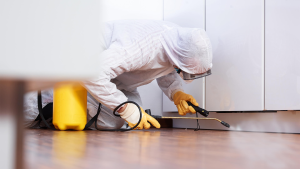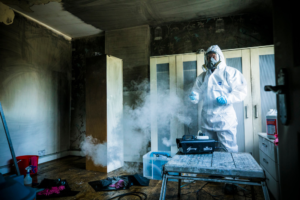Cabinet Refinishing San Jose CA is an effective way to refresh your kitchen cabinets. However, it only works if the cabinet boxes are structurally sound and in good condition. Harsh chemicals or abrasive cleaning products can damage the finish, causing it to chip and scratch more easily.

Refinishing is an eco-conscious option since it eliminates the need for new materials and avoids adding to landfill waste. It also cuts down on dust and mess in your home.
Cabinet refinishing is a great option for homeowners who want to refresh their kitchen cabinets without the cost and hassle of replacing them. This process involves sanding or chemically stripping the existing finish and applying a new stain or paint. This can dramatically transform your kitchen while saving you time and money. Cabinet refinishing is suitable for wood and some engineered materials like medium-density fiberboard (MDF). It can also be used to touch-up or repair minor surface damage.
The first step of a cabinet refinishing project is to thoroughly clean the cabinets, removing any dirt, grease or grime. Then, the surfaces are sanded to smooth them and create an even base for the new finish. This is an important step because it ensures a smooth and even result that will last for years to come. Next, the cabinets are primed to ensure that the new finish will adhere well. Once the primer is dry, it’s time to apply the final coats of stain or paint.
This process can be done by yourself, but a professional can provide you with a much better and more consistent result. In addition, professionals have the experience and expertise to get the job done quickly and efficiently. They can also help you select the right colors and finishes that will complement your home’s style.
There are many benefits to choosing cabinet refinishing over replacement, but the most significant is the cost savings. Refinishing is significantly cheaper than refacing, which is more extensive and involves replacing the doors, hardware and hinges.
Another benefit of refinishing is that it’s a more environmentally-friendly option. Reusing the existing cabinets reduces waste and eliminates the need for additional manufacturing. It also minimizes the amount of dust and mess that is generated during the renovation process, which can affect other areas of your home.
A cabinet refinishing project can be completed in much less time than a refacing or replacement project. This means that you’ll be able to enjoy your newly renovated kitchen sooner. Furthermore, it’s a safer alternative to tearing out the old cabinets, which can lead to structural damage.
Painting
Cabinet painting can give your kitchen a fresh new look without the expense of replacing or refacing cabinets. It can also help conceal stains or scratches on wood cabinets. In this process, your cabinets will be cleaned to remove grease and dirt, sanded to prepare for paint, and then painted with your choice of color. The surface is then sealed to protect the cabinets from wear and tear.
Before you can begin the painting process, it is important to mask and cover anything that you do not want to get paint on. This will prevent any accidental spills or drips that could ruin your final result. It is also a good idea to remove the cabinet hardware, such as knobs and handles, and place them in an easily accessible location. This will make it easier to clean and reinstall the cabinet hardware later.
The next step is to lightly sand the surfaces of your cabinet doors and drawer fronts. This will help the primer and paint adhere to the surfaces. Be sure to use a fine grit sandpaper and sanding block. Once the sanding is complete, wipe down the cabinet doors and drawers to remove any dust or residue left from the sanding process.
Once your cabinets are prepared for the paint, NHance will apply one coat of stain blocking or premium European primer. Then, we will hand-apply multiple coats of paint to the wooden surfaces of your cabinetry. This will give your cabinets a beautiful, rich color.
We recommend Fusion Mineral Paint Ultra Guard for your cabinetry because it dries transparent, enhancing natural wood grain and highlighting light or dark colors. It is also a durable and low-VOC finish, making it safe for your family and the environment.
Professional cabinet painters can save you time and effort by meticulously prepping your cabinets for a flawless paint job. They will use a cleaning solution designed for cabinets and work to remove dirt, grime, grease build-up, and other contaminants. They will also sand the surfaces to ensure an even finish. In addition, a professional will choose the right paint for your cabinets to achieve the exact look you desire and will use sprayers and brushes specifically designed for cabinetry to deliver a smooth, uniform finish.
Staining
Staining is the process of applying pigment to a surface, such as wood, to alter its color and highlight its natural grain pattern. It is a highly effective way to revive old cabinetry and create a new look that is both classic and contemporary. There are many different staining options available, including oil-based stains, water-based stains, and gel stains, each with its own specific coloration, drying time, and application method.
Choosing the right stain for your cabinets is critical to their appearance and durability. A quality finish will protect the wood from daily wear and tear, moisture exposure, and heat and cold, while also enhancing its beauty.
Refinishing is a great option for those who want to refresh their kitchen without the cost and inconvenience of a complete remodel. It is a more labor-intensive process than painting, as it involves stripping the existing finish and sanding to prep the surfaces for the new coating. However, the result is a high-quality, durable finish that can endure decades of use.
While it is possible to perform refinishing on your own, it is best left to professionals to ensure the proper preparation and application of the stain, as well as to prevent any damage or discoloration. This can also help to minimize the amount of dust and mess in your home, as well as reduce the exposure to paint odors and extended downtime.
A major benefit of refinishing is that it preserves the original structure of your cabinets, which can be beneficial for homeowners who have existing structural integrity and value. Additionally, refinishing is a more environmentally friendly option than replacement, as it reduces waste and resource consumption by reusing existing materials.
Unlike refacing, which can take weeks or months to complete and can cause significant disruption to your home, cabinet refinishing is a much quicker process. It can be completed in a matter of days, meaning that you can enjoy your refreshed kitchen sooner and avoid the stress and disruption of a full renovation.
Cleaning
Refinishing cabinets can completely transform the look of a kitchen for a fraction of the cost of replacing them. However, it’s important to follow the correct steps to get a smooth and professional finish. First, all surfaces should be thoroughly cleaned using a degreaser like Tri-sodium phosphate (TSP) to remove dirt and grease buildup. This helps the primer and paint to adhere.
Next, sand the surface of the cabinet to smooth it. This step is especially crucial for older cabinets where the finish has chipped or worn away. It’s also a good idea to use a tack cloth to remove any remaining wood dust after sanding, particularly in nooks and crannies where it can collect.
Once the cabinets have been sanded, it’s time to apply a primer. This will help the new paint or stain adhere and prevent stains from showing up later on. If you’re going to be painting the cabinets, it’s a good idea to select an oil-based primer. They dry much faster than water-based ones and emit less fumes.
Before you begin to paint, it’s a good idea to mask off any areas you don’t want painted or cover them with plastic or paper. This will keep the finished product from getting on countertops, appliances and floors. It’s also important to place a drop cloth under any cabinets where you’ll be working so you don’t end up with paint splatter on the floor.
Finally, it’s a good idea to label or number the cabinet doors and drawers so you can put them back together later on. This will make the process much easier and ensure that all the pieces match up correctly.
It’s also a good idea to clean all of the cabinet hardware before beginning to paint or stain. While there are many products on the market for cleaning cabinets, it’s important to avoid using harsh chemicals that can strip or discolor the finish. Instead, use a mixture of warm water and dish soap.








